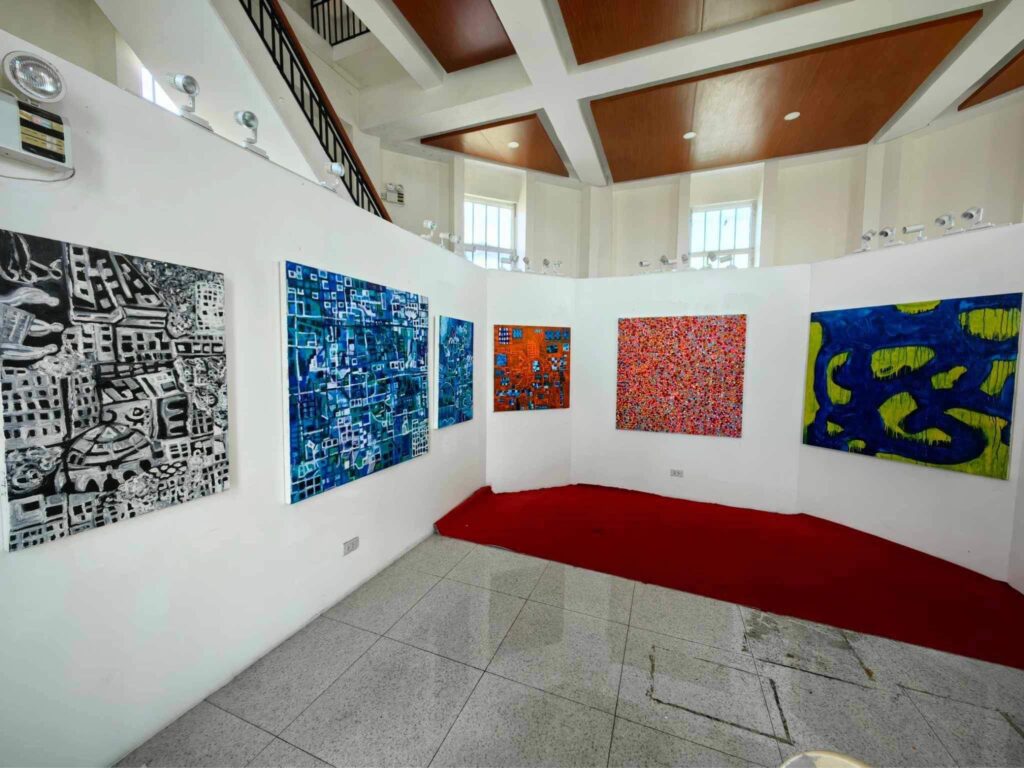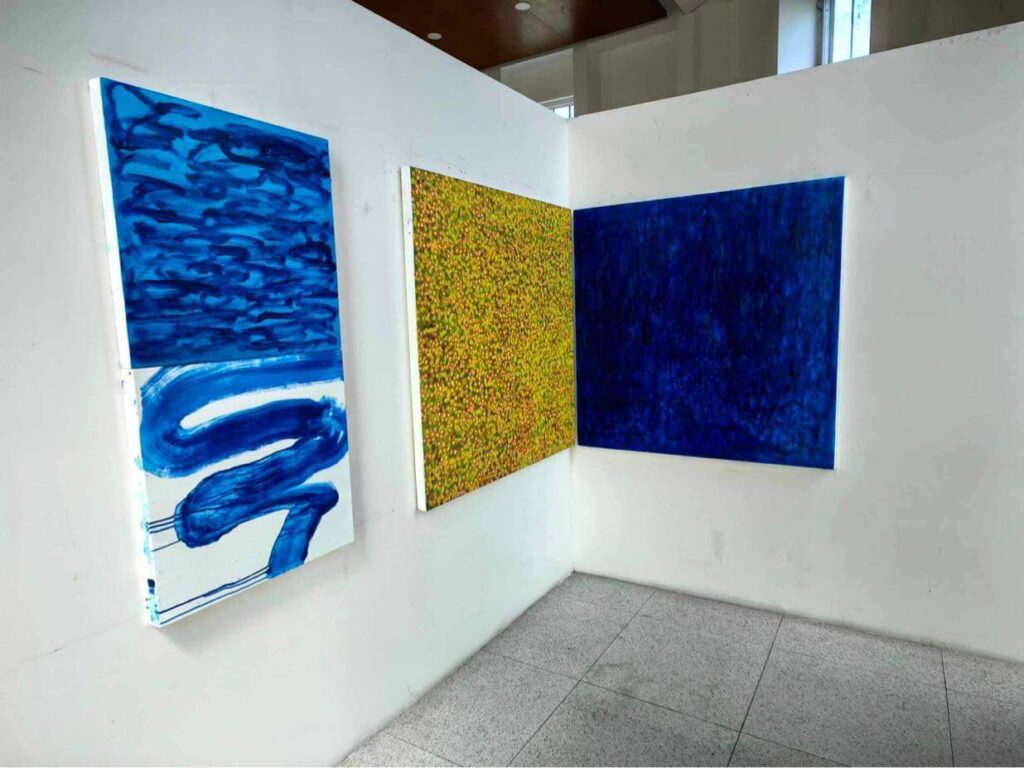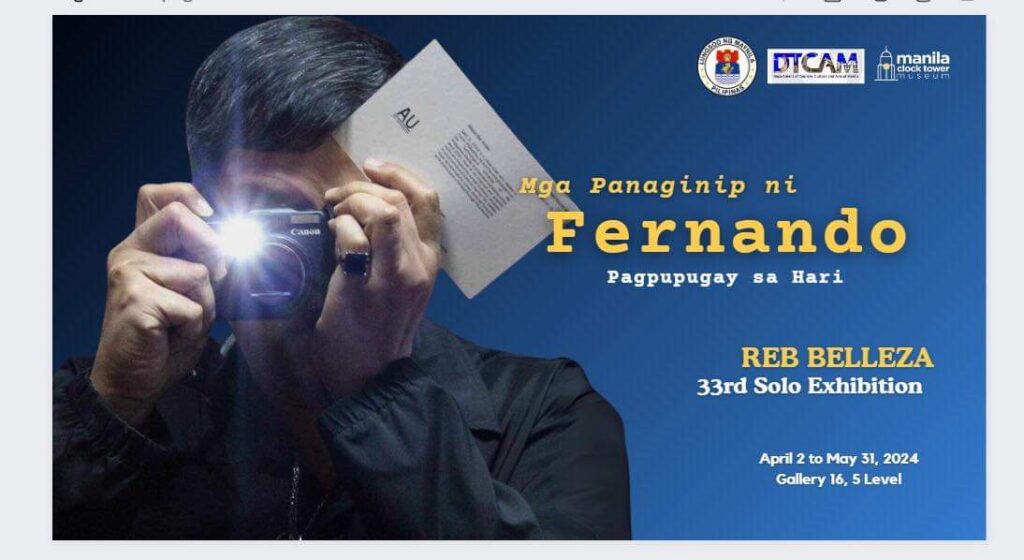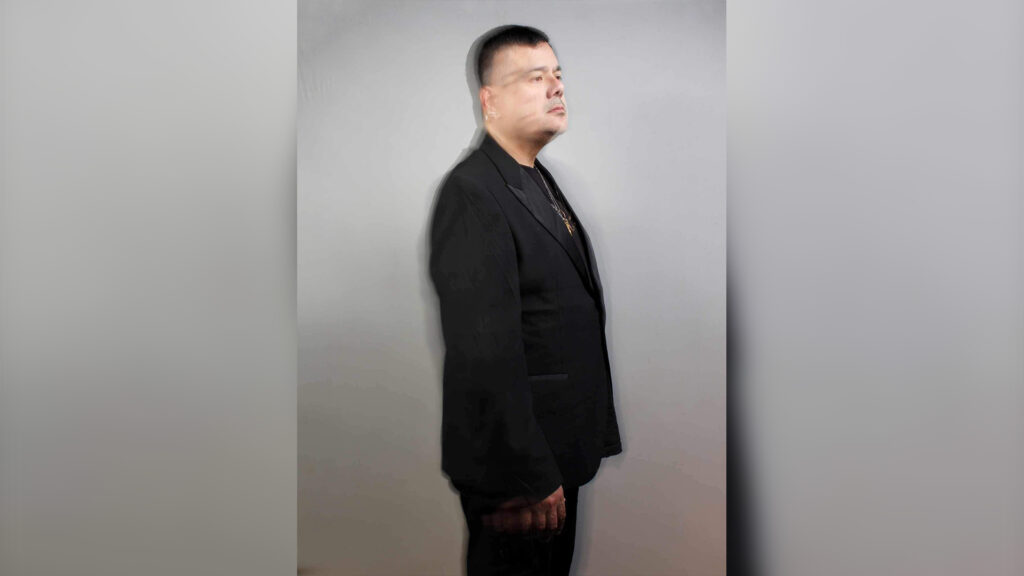‘But beyond the surface, each painting in Reb Belleza’s homage holds a deeper significance, reflecting the artist’s own thoughts and emotions about his godfather’s dreams and unfinished business.’
If you were a child of the 1980s, you would have read or heard of Dranreb, the son of the controversial, beautiful and seductive actress Divina Valencia. Dranreb himself shone as a child actor both on television and in movies. In time, he would be admired by his peers and fans for enrolling at the University of the Philippines to pursue his Fine Arts studies. Along the way, he became better known as Reb Belleza, this time as a multi-disciplinary artist.
Forward to 2024, Reb is paying homage to the King of Filipino movies, Fernando Poe Jr., by curating the exhibit, Ang Panaginip ni Fernando — Pagpupugay sa Hari, which opened yesterday, 2 April, at the Clocktower Museum of the City Hall of Manila. It runs until 31 May.

According to the narrative of the exhibit, which I am sharing with you, it speaks eloquently of what we can expect from this showcase of talent and affection from the artist toward his godfather and mentor. “This captivating homage to the King of Filipino movies, Fernando Poe Jr., is set to grace the walls in a mesmerizing exhibit curated by his godson, the multi-disciplinary artist Reb Belleza. In this extraordinary collection, each painting serves as a poignant symbol of FPJ’s enduring legacy and the dreams he left unfulfilled as the President the country never had.
“With a masterful brush stroke, Reb Belleza breathes life into his godfather’s iconic image, capturing the essence of his larger-than-life persona and the indomitable spirit that made him a legend of Philippine cinema. In the paintings, FPJ is a symbol of his unwavering commitment to the Filipino people and his relentless pursuit of justice.

“But beyond the surface, each painting in Reb Belleza’s homage holds a deeper significance, reflecting the artist’s own thoughts and emotions about his godfather’s dreams and unfinished business.
“He also highlights the color blue, a secret between them. Through vivid colors and intricate symbolism, Reb Belleza explores the themes of longing and loss, hope and resilience, weaving a tapestry of meaning that resonates with viewers on a profound level.
“As visitors meander through the halls of the Clocktower Museum, they will be transported on a journey through time and memory, guided by Reb Belleza’s evocative brushstrokes and the timeless presence of FPJ himself. Here, in this sacred space of artistic expression, the legacy of the King of Filipino movies is celebrated and honored in all its glory, ensuring that his spirit will continue to inspire generations to come.

“And as the final strokes are laid upon the canvas, and the last touches of paint are applied with loving care, Reb Belleza stands back to admire his masterpiece, knowing that his godfather’s legacy will live on forever in the hearts and minds of the Filipino people. For though FPJ may have left this world, his spirit remains as vibrant and powerful as ever, a beacon of hope and inspiration for all who dare to dream of a better tomorrow.”

I am also sharing my online conversation with Reb, a most articulate artist, for your enjoyment.
DAILY TRIBUNE (DT): How do you sign your art works?
James Dranreb Belleza y Fuller (JDB): I sign as Reb Belleza always at the back of the work. Sometimes when a client wants me to sign the work in front, it’s like pulling teeth. I do not like to disturb the painting.
DT: At what age did you start drawing seriously? I mean, were you always the artist of the year in school?
JDB: I started very early in my childhood. I guess being given art materials like crayons, pencils and coloring books at around three years old. I was an artist at school. I always loved art classes or work education. I also dressed the part being a New Waver or Punk which gave me a lot of violation reports because of my outlandish looks. La Salle Greenhills nipped the new wave movement in the bud. You couldn’t even grow your bangs.
DT: Who were your mentors?
JDB: I have several art teachers whose names I forgot. One is a member of The UP CFA Alumni Association whom I exhibit with. Oh, geez dyahe to forget names.
DT: What were your early subjects?
JDB: I would always doodle or vandalize our school tables with drawings, kinda like graffiti. I guess I was self-taught at an early age so I had no mentors in grade school. My go-to inspiration was MAD magazine and comic artist Don Martin. Mazinger Z was a favorite image to draw.
Tiger mom
DT: Tell me about your mom — a strong, beautiful one. What was it like growing up with a mother such as she was?
JDB: Tiger mom. Very strict and a disciplined mom. Early on, we had household duties to do. She never spoiled me even though as a child actor I was earning my own money. She sent me to the US every spring from the age of eight to 15. After Holy Week or after Easter Sunday, I would leave for San Diego or Venice Beach in Los Angeles. She hated me wearing black and grey all the time and having spiked hair. I remember she didn’t not spare the rod. I was spanked a lot.
DT: Tell me about your UP education. How did it shape you into the person that you are today?
JDB: UP was freedom and my first coed experience coming from an all-boys school. I still go back to UP when I have the time. I just had a solo exhibit at the Bahay ng Alumni last August. It felt like a great homecoming. The romanticized view of the beloved university. I made a lot of friends who are my friends or peers up to this day. I subscribe to academic freedoms. My professors became mentors like Prof. Ruben Dodo Defeo and Ma’am Ginny Dandan, who we just lost in this earthly plane. Prof. Virginia Agbayani, or Manang Betty as we call her, also became strict advisers and mentors. I am closest to Sir Dodo. UP is who I am today. My principles in life. I love my university. I try to give back whenever I can.
DT: Tell me about your USA education. What did you finish, what did you learn, who were your top mentors?
JDB: I lived a block away from a City College I chose to attend — Santa Monica College. I had the same teachers as the ones from Otis Parsons (they changed the name now) and UCLA. Tuition was more affordable. I took up French and continued Visual Communication there. I speak French fluently because I never stopped learning from 1989. My teacher was an American who had a strange French accent and also a French teacher who taught me the right accent, but my accent is a bit African when I speak it. I learned how to make music videos in one class I had. I was a teacher’s pet. I had one summer at UCLA where I crossed enrolled to study Art History. But I kept reading and reading books and watching documentaries while studying there.
Homesickness got the best of me so I told my ‘Nong if I could go back to home and shift to Studio Arts at UP. He said yes. So, three years of college life in the US with a part-time job as a sales associate at Fred Segal Man in Santa Monica. I lived a very happy well-balanced life when I was there. I wanted to make my ‘Nong proud and my mom.
DT: Did you experience any culture shock?
JDB: No culture shock. I am Filipino-American. From 1970 to 1973, I lived as a child there. I would always spend spring vacations in America from here in the early to mid-‘80s, and finally moved to study in ‘89. So, there was no adjustment. I could shift to my American accent anytime. Slang. I missed home a lot though, but I had schoolmates from La Salle living there so there was also that community.
An artist with everything
DT: What exactly is a multi-disciplinary artist? What have been the highlights of your artistic career?
JBD: I can’t explain that. It’s me as an artist with everything I do and think. If you can say that I’ve done photography, video art installations, performance art, theatre, acting and painting, is that multi-disciplinary? It’s like even when I dress up, I think there’s an art to that. I love fashion and consider myself a fashion plate and a fashion victim.
Highlights? Venice Biennale, 1999. Philippine Center NYC solo exhibit, 1995. La Mama NYC exhibition, 2008. Are they highlights because they were held abroad? Yes and no. It was just a different experience because they opened me to many cultures — and sharing my being Filipino. I’m more Filipino abroad and more American here. I don’t understand that myself.
DT: Who are your idols in the arts and how did they influence you?
JBD: Popo San Pascual is my real guru. Gus Albor is my mentor and great friend. Pardo De Leon is like my art compass and a big sister to me. Manuel Ocampo because of his freedom to express himself. Jet Melencio for his concepts. Internationally, it’s Damien Hirst because of his works and success. And many other artists like the members of the Collective we founded — The Brut Collective. Ron Lopez Davis, his paintings kick ass. David Kaufman because of his grit and confidence. San Dino whom I think is my ward because he is the youngest in our collective. His sculptures. Those three other members of The Brut Collective inspire me. I see colors, gestures and ideas in my works now ever since we got together. We speak to each other every day. It also helps that we have our eyes in Madrid because David lives there half of the year. Ron, who is also a great X chef, gives inputs and is our businessman. So, we get ideas and share them. It is such a dynamic group. And my secret weapon? My wife Valé. She is my curator and adviser.
His time was his best gift to me
DT: Tell me about your relationship with your Ninong FPJ. How was he as a ninong? What memorable gifts did he give you when you were still a child?
JBD: My relationship with him? Like a father to a child. Like a master to an apprentice. Like my best friend. My disciplinarian. My inspiration. There were so many gifts. But the best gift he gave me was his time.
DT: As you grew into a teenager and a young man, how did your relationship with your Ninong FPJ evolve?
JBD: He was present. His lessons. Sometimes like secret puzzles you have to discover the answer to. I was so jealous I remember when he started making movies with Niño Muhlach. It evolved naturally — from a child to a young man. Some things are left to oral history about my relationship with him. I’d like to keep them secret. But the way I think, I guess some I learned from him. He was a great teacher. He was a shaman. A priest. He is like Confucius.
DT: What was his advice to you that you have kept to this day?
JBD: I am living my life with his lessons. How I live it is thanks to him and my mom and all my godparents. And the community of people that helped raise me.
DT: How do you pay tribute to him in this art exhibit? How present is he in this exhibit?
JBD: Please come watch it. I can’t explain it to you.
